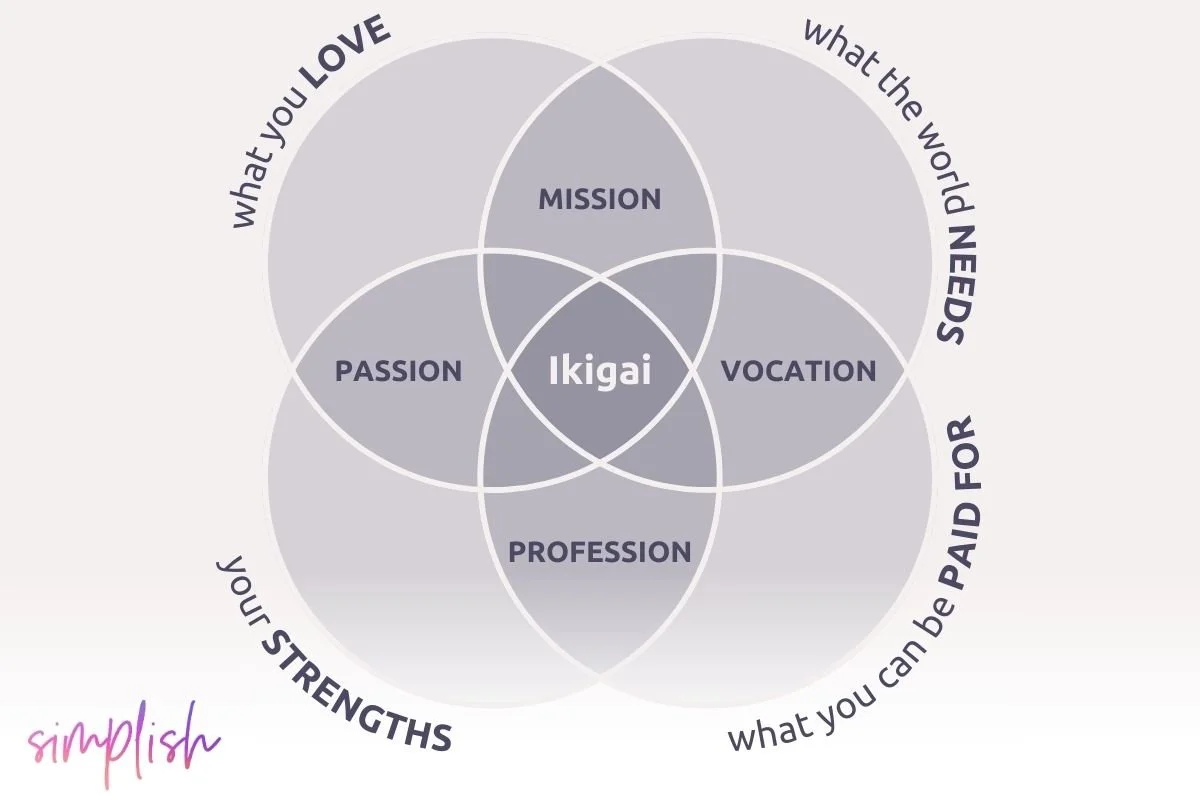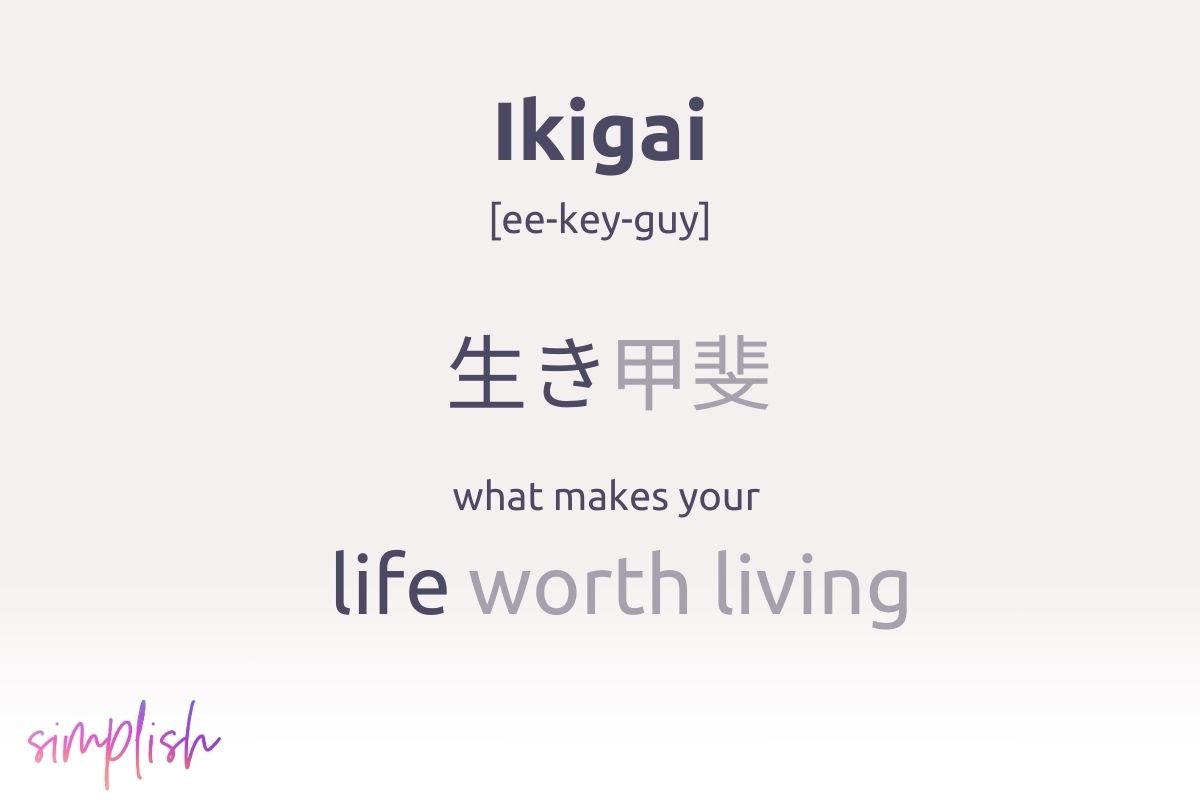How Finding Your Ikigai Can Balance Your Life (+Tips)
Do you ever feel like when one thing is going well in your life, another falls apart?
Maybe you get a promotion at work while your marriage is falling apart, leaving you overworked and unhappy. You might have kids, and then mourn the loss of close friends. Or maybe you move to the city to pursue a passion and wonder if it was worth the risk when financial insecurity sets in.
This constant push and pull is a natural part of life.
But if you return to the feeling that you just can't "have it all" again and again and again, it might be a sign that you need to reflect on your purpose in life.
The Japanese concept of ikigai offers insight into how.
The term ikigai combines “iki” (life) and “gai” (worth) to represent the idea of a life worth living. While ikigai is often used as a system for career coaching in Western contexts, its true essence encompasses your entire outlook on life. This article explores what ikigai truly means, its benefits, and how you can discover your own.
What is Ikigai?
Ikigai is a deeply rooted Japanese concept that translates to “a reason for being.” It’s about finding that which gives you a sense of fulfillment and motivation in your everyday life. Unlike the common Western interpretation that narrows ikigai down to career fulfillment, in Japan, it is more about a holistic sense of well-being and joy that can be found in various aspects of life, not just work.
Benefits and Joys of Finding Your Ikigai
Living a purpose-driven life brings numerous advantages, from personal satisfaction to inner clarity. Finding your ikigai can help prevent burnout and guide you toward a life that feels meaningful and aligned with your true passions. Below are some specific benefits of discovering your ikigai:
Sense of direction: Having a clear understanding of what drives you can provide a strong sense of direction and purpose.
Clarify your priorities: Understanding your reason for existing is maybe the most under-rated prioritization method out there. Forget starting your day with Eat the Frog and remember why you're waking up in the first place! From this enlightened starting point, setting your priorities in order becomes almost effortless.
Experience of flow: Engaging in activities that align with your ikigai often leads to a state of flow, where you are fully immersed and energized.
Discover your passions: Discovering your ikigai helps you identify and pursue your true passions, leading to a more fulfilling life.
Live your core values: Reflecting on your ikigai will naturally guide you to reflect on your core values, e.g., what's most important to you. Finding your purpose will present clear opportunities to live in alignment with your values in daily life.
Inner clarity: Understanding your ikigai brings inner clarity, making it easier to make decisions that align with your values and goals.
Red Flags That It’s Time to Reflect on Your Purpose
Sometimes, we need to take a step back and reflect on our life choices to ensure we are on the right path. Here are some common red flags that may indicate it’s time to reconsider your purpose and seek your ikigai:
Dissatisfaction with life: Feeling a persistent sense of dissatisfaction, disappointment, and unhappiness in your daily life.
You need a break: Whether you're choosing to take a career break or have been forced to take time off work to manage burnout, illness, or another crisis, it's a good time to reflect on your purpose.
Conflicting roles or goals: If you find yourself pulled between the opposing demands of different roles in your life, perhaps as a parent and worker, it's worth considering what is most important to you and perhaps re-evaluating your long-term goals as well
Low motivation: Experiencing a significant drop in motivation and enthusiasm for activities you once enjoyed can be a major red flag for purposeless-ness.
Overwhelming busy-ness: Everyone gets busy from time to time, but if you feel constantly overwhelmed by the busyness of life, it's a good time to reflect on the why behind it all
The Ikigai Diagram, Explained (+Critique)
The Ikigai Diagram, popularized by the English business coach Marc Winn in 2014, is a visual tool that helped popularize the Japanese concept of ikigai. In a simple, fill-in-the-blank-friendly-form, Winn's ikigai diagram invites you to write down what you love, what you are good at, what you can get paid for, and what the world needs as a way to find what is common between these activities.
Print the diagram below and fill out the sections with pen to see for yourself!
The ikigai diagram popularized by English business coach Marc Winn
What You Love: This section focuses on your passions and interests. Examples include hobbies like painting, writing, or playing sports.
What You Can Get Paid For: This area highlights potential career paths and income-generating activities. Examples include professional skills like teaching, engineering, or digital marketing.
What You’re Good At: This part considers your talents and skills. Examples include abilities like coding, public speaking, or culinary skills.
What the World Needs: This section addresses societal needs and how you can contribute. Examples include social work, environmental conservation, or healthcare.
Ikigai is a broad concept. Infographic based on Japanese wellness coach Saroi Okada’s argument against using the ikigai diagram.
While fun, handy, and surprisingly practical, the ikigai diagram also has it's limitations.
According to Saori Okada, a Japanese wellness coach, Winn's ikigai diagram oversimplifies the concept and misrepresents the true essence of ikigai. In her critique, Okada points out that ikigai is not merely a formula for career satisfaction but a holistic approach to living a meaningful life.
She emphasizes that “the real Ikigai reminds us that we are the ultimate framework, and we have to look at our lives holistically, from both a personal and professional point of view, to find fulfillment.” Okada suggests considering the meaning of the world ikigai itself as a guide to understanding purpose on a day-to-day basis.
Tips for Discovering Your Ikigai
Ready to dive in and discover your purpose? Finding your ikigai involves introspection, exploration, and sometimes, trial and error. Here are some tips to guide you on this journey:
Read Books on Ikigai
Not quite sure if you "get" ikigai yet? Keep reading. Ken Mogi, a Japanese neuroscientist, writer, and broadcaster based in Tokyo, is one of the leading experts on ikigai, and has published a number of best-selling books on the philosophy. We recommend The Little Book of Ikigai: The Secret Japanese Way to Live a Happy and Long Life from our collection of book recommendations on purpose to get started.
Reflect on Your Feelings
Spend time reflecting on what activities make you feel most alive and fulfilled. Consider keeping a journal to document your thoughts and feelings. This practice can help you identify patterns and understand what truly brings you joy.
Identify Your Personality Traits
Understanding your personality can help you find activities and careers that suit you best. Take personality tests or seek feedback from friends and family to gain insights into your strengths and preferences.
Plan Meditation Into Your Daily Routine
Regular meditation and mindfulness can help clear your mind and connect you with your inner self. This practice can provide insights into what truly matters to you and help you stay grounded in your journey toward finding your ikigai.
Break Down Goals Into Actionable Steps
Break down your goals into actionable steps. Create a plan to pursue your passions and align your daily rituals with your long-term goals. This approach makes the journey toward finding your ikigai more manageable and attainable.
Take Time for Reflection
Regularly set aside time to reflect on your life choices and adjust your path as needed. This can help you stay aligned with your ikigai and make meaningful progress toward your dream life. Reflection helps you stay connected with your evolving desires and aspirations.
Embracing the Process of Finding Your Ikigai
Discovering your ikigai is a journey that involves understanding yourself deeply and aligning your life with what truly matters to you. While tools like the ikigai diagram can provide initial guidance, it’s essential to approach this process holistically, considering both personal and professional aspects of your life. By reflecting on your feelings, identifying your personality traits, incorporating meditation, setting actionable steps, and taking time for reflection, you can find your ikigai and live a more fulfilling, purpose-driven life.
Remember, evolves as you grow and change, allowing you to adapt and find new sources of fulfillment and joy throughout your life. Embrace this journey with an open heart and mind, and you’ll discover the true essence of ikigai.


